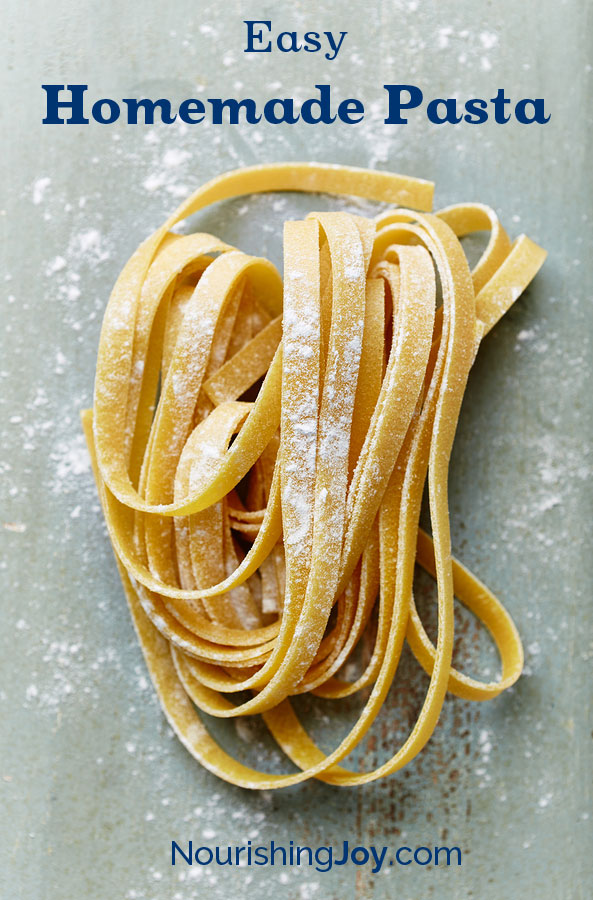How to Make Fresh Pasta

For some of the world, noodles are traditionally made with merely flour and water. In other parts, traditional pasta is flour and eggs. But for modern cooks who like things richly flavorful yet easy to put together, pasta is made with flour, eggs, olive oil, and salt. This gives the greatest elasticity to the dough and makes the pasta light and rich as it cooks.
Prep Time:
Cook Time:
Total Time:
Ingredients:
| 2 cups | of flour (if using freshly ground flour, have an extra 1/2 cup on hand depending on the hydration rate of your particular flour) |
| 3 | eggs |
| 1 teaspoon | olive oil |
| 1/2 teaspoon | sea salt |
Directions:
Place all ingredients in the bowl of the mixer fitted with the dough hook. Mix until a cohesive dough is formed and the dough pulls away from the sides of the bowl. The dough should be just slightly sticky. Add more flour by the teaspoonful if needed, but keep the dough as soft as possible. If the dough is too dry, add a little water; if too wet or sticky, add a little flour.
Knead for another 5 minutes. Cover the bowl with a damp kitchen towel and let it stand for 20 minutes.
If you have a pasta machine, this process is much easier, unless you have the dexterity of an old Italian mama who is able to roll out paper thin pasta sheets with nothing but a rolling pin. That is not me, I'm afraid, so I much prefer the rolling machine.
If you'd like to roll by hand, however, divide your dough into two pieces, keeping one covered to prevent drying out. On a large floured work area, flatten the dough into a disk. Working from the center at all times, use a rolling pin to flatten the disk out from the center to the outer edge. With each roll, rotate the dough one-quarter turn and flip the dough over once or twice to ensure the dough is not sticking. Roll out the dough to about 1/16? thick or desired thickness, depending on the type of pasta you are making.
To roll out using a machine, divide your dough into 6-8 balls. Keep the balls you are not using at the moment covered to avoid drying out and do the entire process with each ball before moving on to the next one.
Flatten the ball slightly with your hands and roll it through the machine on the widest setting (on my machine, the widest is #1). After each pass, tri-fold it and roll it again on the next smallest setting – this will ensure the most evenly shaped sheet of pasta. Continue to reroll them on progressively smaller settings until you reached the preferred thickness. For stuffed pastas, stop at #6 or 7. For long pastas, such as spaghetti, tagliatelle, and linguine, stop at #6. For lasagna sheets, roll to #8 or 9.
If you have a machine attachment to shape the pasta, attach it now and roll each sheet through, catching the cut pieces on the other side. If you don't have a cutting attachment, lay the rolled pasta sheets on a floured surface and use a sharp knife, bench scraper, or pizza cutter to cut the pasta into strips.
Set strips on floured tea towels or drape them over a long broom handle, being careful not to let the pieces touch if at all possible. For lasagna, there is no need to cut them. If you have a pasta extruder, such as for macaroni or conchi, you skip the rolling and go directly to the shaping.
Cooking and Storing the Pasta
To cook the pasta fresh, bring a pot of salted water to a boil. Add the fresh pasta and cook for approximately 2 minutes. Fresh pasta reaches the al dente stage very quickly, so be ready.
To store the pasta, let the strips dry for several hours, turning them if necessary to dry thoroughly. You may also dry them in your food dehydrator for 2-4 hours at 135 degrees. When they are dry, place them in airtight packages. If you don't have a way to dry them, flour the strips well to keep them from sticking, place them in freezer-safe bags, and freeze them for up to two weeks.
Source: nourishingjoy.com
